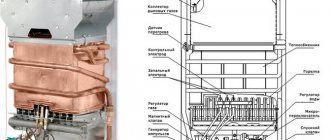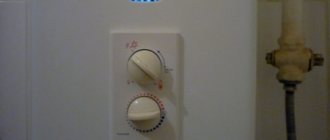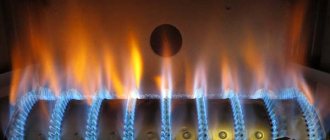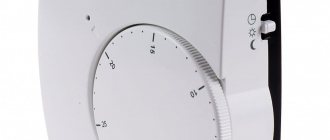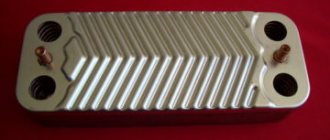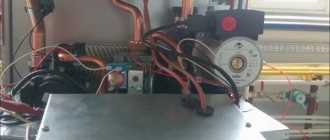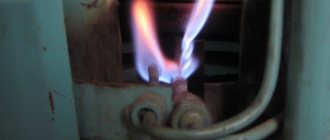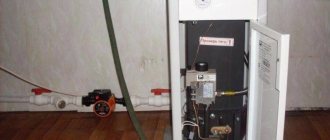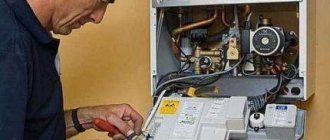The automatic gas control system “closely monitors” the operation of the dispenser and, at the slightest failure or disruption in operation, will shut off the gas supply, protecting the user from further poisoning. But, like all complex technical products, something can go wrong and the gas control system will turn off the gas water heater for no apparent reason. When contacting our center, customers describe this malfunction as follows: the gas water heater lights up and goes out. Let's take a closer look at this breakdown and the reasons for its occurrence.
Typical problems
Let's look at why the gas water heater goes out.
Attenuation can be caused by a number of reasons. A sensor may turn on and detect a gas leak. There may be problems with the operation of the chimney. A clogged igniter will also often cause damping problems. Sometimes the automation fails. Often the problem of attenuation is also related to the quality of the fuel. Some gas facilities do not supply pure gas, but diluted gas. Such low-quality fuel is easily identified by the orange color of the flame. If serious automatic protection systems are installed in the column, they will turn off the system
It is also worth paying attention to gas leaks. Even minor leaks are the reason why these units fail
Repairing geysers at home can help. But you should only turn to professionals - gas is not something to joke about.
Ways to prevent malfunctions
When purchasing a device, you should pay attention to the minimum water pressure required for the normal functioning of the device. The passport data must be compared with the water pressure in the apartment.
For the column to work properly, you must:
- carry out preventive maintenance once a year or more often;
- inspect the chimney a couple of times a year and clean it, if necessary;
- clean parts from scale and soot;
- provide adequate ventilation.
And don’t forget to change the batteries on time.
Does water pressure affect the performance of the column?
The reason why the equipment does not ignite may be low water pressure in the supply water supply. This is easy to check; you just need to open the cold water tap at the sink. If you see that the pressure is weak, then this is the reason. But if the pressure is excellent, then the problem of the malfunction lies in the water unit of the gas device itself. Most likely, the filters are clogged or the special membrane is deformed. In some cases, the hot water supply tap becomes clogged and becomes covered with scale from the inside.
In very rare cases, the cause of low pressure is a deep cleaning filter, which is installed additionally. How to fix the problem? If the cold water supply pressure is very weak in the general water supply system, you need to call the utility services to find out why this is happening. If the column does not light up due to the fact that the filters are clogged, then they should be removed and washed using special means.
If the filters are heavily soiled, they need to be replaced, as cleaning them is no longer useful. If the hot water pipes are clogged, you need to call a technician who can clean them; you do not need to do this work yourself. If the membrane is deformed, there is no need to try to straighten it; you need to purchase a new one and install it. If the column becomes clogged with combustion products and soot, turn it off, then remove the casing and clean its components from traces of soot.
The column refuses to light up when turned on or goes out immediately, due to the fact that the supply of cold or hot water is not adjusted. In this case, there is no need to try to dilute the hot water by increasing the flow of cold water, as this will lead to a gradual attenuation of the flame and the column turning off. Such incorrect actions lead to a reduction in the service life of the device. It is also necessary to correctly adjust all the taps during installation; if you cannot do this yourself, then it is better to call a specialist.
Pollution prevention
If the water heater produces weak water pressure, it is worth not only removing the blockage, but also taking care of prevention.
What to do for normal operation of the gas water heater:
- Prevent the appearance of scale and salts. Clean parts of the device periodically. But the number of procedures can be reduced by choosing the optimal temperature regime.
- The heating temperature should not exceed 50 degrees. Therefore, it is worth choosing one indicator and making sure that there are no sharp jumps.
- Install a water filter that will retain salts and prevent them from damaging the surface of the pipes. Replace it with a new one in a timely manner.
- Install an electric softener to reduce the risk of scale formation.
- Clean the column correctly. Contact a specialist to check the quality of work. He will appreciate how hot water is supplied.
Problems and their solutions will not disturb speaker users if they prevent contamination and properly care for the device
It is important that the water is soft and clean. If the pressure decreases, you should immediately check for contamination and clean it with gentle means.
The geyser goes out when switching to shower
Does the heater keep turning off when switching to shower? What's happened:
clean the chimney; replace ignition batteries; remove scale and soot from instantaneous water heater components; Ensuring good air ventilation in the room is important not only for the normal functioning of the device, but also for the safety of people.
These are the most common problems that cause the gas water heater to turn off and go out. As you can see, in most cases the owner of the device can eliminate them on his own. If repairs are unsuccessful, or maintenance requires special equipment or knowledge, you should call a qualified specialist.
Step-by-step instructions for troubleshooting gas water heaters
Apartment owners can identify and eliminate some faults themselves, except those that affect the safe operation of gas water heaters and warranty repairs. If the geyser starts making popping noises, doesn’t want to turn on, and the warranty period has not yet expired, then the issue is easily resolved. Call a specialist to your home. Gas water heaters begin to “pop” after 5–10 years of operation without periodic maintenance.
Checking the draft in the chimney of a gas water heater
It should be borne in mind that the apartment must have not only a chimney, but also a ventilation duct. Both must have sufficient draft to remove combustion products and foreign odors both in the bathroom, toilet and kitchen. If gas leaks, some of it will be removed through the ventilation duct.
If gas is not completely burned, carbon monoxide can form. There is a misconception that carbon monoxide can rise up and be removed through ventilation. It is heavier than air, has no odor and will slowly fill the room. Carbon monoxide, chemical formula CO, is a free radical seeking oxygen to join. Once in a person's lungs, it takes oxygen from the blood, and the person suffocates. Therefore, there can be no jokes with a gas water heater that started making popping noises. Checking the traction:
Use an anemometer. We can assume that no one has it, so we move on to the second method. Use thin tissue paper. Place it on the ventilation duct. It should stick to the ventilation grill and not fall. Do the same to check the chimney duct.
To check the chimney, use a match or lighter with care to avoid igniting the soot. The flame should be strongly drawn into the channel. If there is no draft, you will have to clean the chimney
If there is no draft, you will have to clean the chimney.
The draft is significantly affected by a heat exchanger clogged with soot deposits. To clean it, disassemble the gas water heater. If you don’t have the skills, then entrust this work to a mechanic from a company that is licensed to service gas equipment.
Gas pressure
If the gas water heater does not light up when you turn on the water, the reason for this situation may be problems with gas pressure or a complete lack of gas in the system.
In this situation, usually the water pressure is normal, and the piezoelectric element gives a spark. The first thing you need to do is check the presence of gas in the gas pipeline; to do this, you need to try turning on the gas stove. If the stove does not turn on either manually or automatically, and the characteristic hiss of flowing gas is inaudible from the burner, then with a high probability it can be said that there is no gas in the gas pipeline.
The option when gas does not flow in the gas column while there is normal gas flow to other devices and when there is a spark on the piezoelectric element indicates a malfunction of the gas equipment or a clogged gas filter. When the gas water heater does not ignite when the water is turned on and the ignition system is activated, it is necessary to check the condition of the gas filter installed in front of the device.
The fact is that the composition of natural gas, the presence of impurities and gas condensate can clog the gas purification filter. Because of this, the gas pressure decreases, the pilot light does not light, or the gas safety valve turns off. One of the symptoms of filter contamination can be cases when the device does not light up immediately, or if it does turn on, it starts working intermittently at first, and then after a few minutes it reaches the desired mode.
What to do if the gas water heater does not light up due to low gas pressure or a clogged filter? First of all, you need to turn off the gas supply valve and open the vents for ventilation. Next, you need to inform the gas service about the problem and if this is not a centralized gas shutdown, then call a gas service technician.
The main thing in this case is not to try to do the repairs yourself and wait for the specialists to arrive.
Valve adjustment
To do this, you need to remove the water-gas block from the apparatus and divide it into a water and gas component.
When the hot water valve opens, the membrane deflects. And the rod of the first component moves and presses on the rod of the second component of this block.
The microswitch trips. The control unit generates a spark and blocks the movement of gas to the burner using an electromagnetic valve (EMV).
Design features of gas devices
Some gas stoves of certain European brands are noisy by definition. This is due to their design features and the introduction of technologies aimed at saving resources. These technologies allow you to save gas.
To maximize gas consumption, this stove uses the turbo effect. Some modern burners have two or three rows of perforations (unlike older devices), which results in faster heating. But this can also cause additional background noise.
Those. The combustion intensity increases, but due to all the innovations, the burners begin to make a lot of noise. In addition, on new stoves, the burners suck in air directly under the flame, which is why characteristic sounds are heard (whistles, hissing, tapping, etc.).
On old tiles, this process took place inside the burners, so it was barely audible. If the noise is too loud, you can try to reduce it by increasing or decreasing the gas.
When purchasing modern gas stoves, you need to be prepared for the fact that it will not be possible to completely get rid of the noise of the burners.
Also, the appearance of background noise when a gas stove is operating may be associated with the installation of inappropriate parts. A set of new plates often contains additional elements that can be mistaken for spare parts, but they are not.
In most cases, such parts are designed for different gas pressures. But only an employee of the GorGaz department, with whom the owner of the residential property has entered into an agreement for the maintenance of gas units and the supply of blue fuel, should replace parts of the gas stove with new suitable elements.
If an ordinary gas stove was moved from an apartment with main gas and installed in a country house, connected to a cylinder, and it began to make noise during operation, then in most cases this is due to unsuitable jets.
The jets are responsible for supplying gas in the required volume at a certain pressure. The fact is that the gas in the main pipes and cylinders has a different composition, therefore the nozzles differ in structure and size.
What if the equipment is still noisy?
If, after these manipulations, the gas water heater still ignites with a bang when you turn on the water, then it is better to stop further independent research. In such situations, you will have to seek help from qualified specialists.
They will carry out competent diagnostics of the equipment, will be able to clearly determine what is causing the cotton and, based on the data obtained, will be able to provide you with options for solving the problem.
In certain cases, independent repair is impossible, then cooperation with qualified specialists will be a rational solution.
Conclusions and useful video on the topic
Finding the cause and ways to eliminate the problem of speaker attenuation can be found here:
Column attenuation is a symptom of an internal malfunction or violation of the operating conditions of the device. You need to correctly find out the cause of the problem, after which a significant part of the described breakdowns can be eliminated yourself. But to solve complex problems you will have to contact a service center.
Do you have any questions when searching for the cause of speaker attenuation? Ask them under this article - our experts and site visitors will try to help you.
Or maybe you want to tell other users about the problems that arose with your speaker during operation, and how they were successfully resolved? Share your experience and leave recommendations in the block below.
Principle of operation
This wall-mounted water heater does not have a storage tank for storing and heating water. The device is compact in size. The water temperature rises instantly as it passes through the heat exchanger. The main advantage is the provision of warm water to several water intake points simultaneously. The energy source of such water heating systems is natural or bottled gas. This is precisely what explains their popularity of installation in those houses where installation of gas equipment is possible.
Gas is cheaper than electricity, and although the cost of such units is several times more expensive, they pay for themselves during operation. In turn, the quality of these raw materials must be at the proper level, otherwise the service life of the equipment will not be long. In addition, constant clogging of the filtration system due to the poor quality of the gas mixture will lead to the device constantly turning off.
Read more about the design and operating principle of a gas water heater.
Actions with Neva
Geysers from this company have various modifications. Each has its own weaknesses.
There are often cases when users find it difficult to turn off the Neva gas water heater with index 4511
The most common causes of this problem in this model are:
- Problems with the water block.
- Flow indicator (micro switch) failures.
- Low battery voltage.
The arrangement of elements in Neva 4511 looks like this:
Here the operating principle of the water and gas units is identical. That is, when water opens, the membrane of the first component bends and puts pressure on the rod of the second. The EMC opens, gas flows to the main burner.
The batteries power the control mechanism, which is responsible for ignition and other processes in the device.
The microrelay is located under the water block in a free state. When the rod of the water mechanism moves, this relay closes, and current flows from the batteries to the control system.
Due to the indicated reasons, failures occur in these processes, and the device does not turn off.
To solve the problem there are the following methods:
- Repairing or cleaning the water block. It is better to trust the work to experts.
- Replacement of microrelay.
- Installing more powerful batteries.
What other reasons are there for extinction?
Failure of the gas water heater can also be caused by these elements.
Outdated membrane
The polymer material from which the membranes are made has sufficient elasticity, but after many years of use it disappears and the element becomes rigid, and it is possible that cracks or lime deposits may appear in it. Such defects will not allow the gas water heater to work regardless of how the tap is opened. Therefore, it is worth removing and inspecting the membrane: if its condition causes concern, a replacement for this element should be found as soon as possible.
Ignition system and piezo element
In devices that do not have an igniter, its functions are performed by electronic ignition, where the spark is generated by batteries. Perhaps the fault lies with them, since they are not always able to work for a whole year. In other geysers, a piezoelectric element driven by a water turbine is responsible for producing a spark. Such an ignition system will not help if the water pressure is low.
A regular igniter is also at risk of clogging; this can be easily determined by the yellow color of the flame. If the burner ignites with a loud bang, this is your case. After cleaning the element, everything returns to normal.
The shower turns on - the speaker goes off
If the water heater only turns off when the shower is turned on, then it is entirely its fault. The reasons may be:
- The mesh filter installed in the shower head is clogged.
- When the watering can becomes clogged, the water pressure decreases. You can try to unscrew it. If the column starts working, the reason has been found.
- The inner rubber pipe of the hose has become twisted, blocking the flow of water.
Reasons for column attenuation after ignition
When identifying the cause of a malfunction, it is important to pay attention to two points: how the igniter goes out (are any extraneous sounds heard); this happens immediately after ignition or already during the combustion process.
Reason #1 - failure of the flame ionization sensor
If the device turns on and goes out, the ionization sensor is 70% to blame.
This element is constantly in contact with the flame. The ions produced during the combustion process are attracted to the sensor and produce a current. If there are enough ions, the device works. If there are few of them, the column does not function.
The ionization sensor is a thermocouple that is heated by a flame. It is also called a gas sensor because it prevents the device from leaking when the burner is turned off
Signs of malfunction:
- the burner went out 3-5 seconds after ignition;
- when restarted, the device operates longer;
- You just need to start the device several times and it is already functioning normally;
- problems appear only after a long break.
It is necessary to inspect the wiring that runs from the part to the control board. Why do we check all contacts? Then unscrew the holding screws and place the heating electrode at the hottest point of the flame.
This technique can extend the life of the sensor by another year. If everything is in order with the contacts and connections, the element needs to be replaced.
Reason #2 - the membrane of the water unit is worn out
A polymer part must have sufficient elasticity. Over time, this property is lost - the element becomes hard, cracks, and becomes overgrown with scale.
A water block or “frog” is a fairly simple device. The cover is held together with screws, by unscrewing which you can get to the membrane
If the element becomes unusable, the heater will go out. It is necessary to inspect and replace the membrane, if necessary, with a more durable silicone one.
Reason #3 - the wick is clogged with dust
In models with an igniter, this part often becomes clogged. The flame becomes weak and a yellow tint appears. But a change in the color of the flame may also indicate a lack of air in the gas-air mixture.
The result is that the device is either completely unable to ignite the burner, or performs its function after a large volume of fuel has been supplied. In the latter case, a characteristic bang is heard.
To clean the element you will need two screwdrivers (Phillips, slotted) and an adjustable wrench.
The algorithm is as follows:
- We remove the case - pull out the adjustment knobs, unscrew the bolts in the corners from the bottom, lift and remove the cover.
- We unscrew the draft sensor tube and the one that supplies fuel to the wick.
- We unscrew the screws and disassemble the structure.
- We clean the nozzle, blow out the tee, and assemble it.
There may also be a blockage in the draft sensor, which causes the igniter to smoke. After removing dust and dirt, the pilot light should burn with a stable blue flame.
After cleaning, the device may make a slight noise. The sound is produced by air that is sucked in through the slots in the wick guide housing. There is no danger, but the noise can be eliminated if you slightly tighten the wick with screws
If desired, all parts of the structure can be washed. But don't forget to dry them well before assembling.
Not enough charge
When you open the water, you observe a normal flow, when you turn it on, there is a characteristic click, a spark is formed and everything is generally visually good. But there is one noticeable point: the burner itself in the gas water heater does not ignite. If you look through the window, there is no flame. This is the reason why there is no hot water. The owner does not have hot water, which causes a lot of inconvenience. This reason must be eliminated as soon as possible.
The reason for the malfunction and lack of hot water lies in a completely simple phenomenon. When the batteries stop working, the speaker stops functioning. It does not heat up and therefore the hot water supply stops.
The battery charge in the final stages is only enough to produce a spark. Therefore, visually you observe a spark, and there is also a noticeable click. But the battery energy is not enough to ignite the burner itself.
Replacing the batteries yourself is not difficult. To do this, you need to open the box with the batteries and take them out. Next, you should replace it with new, high-quality, powerful batteries.
More about batteries
Polarity in batteries matters. If you insert batteries without taking into account their polarity, the column will not light up. Batteries can sometimes get stuck in the pack, so keep an eye on them.
Replacement with new functioning batteries is carried out if two main criteria are met:
- The polarity of the batteries must be taken into account;
- The box intended for batteries must be closed until it clicks.
The batteries used in geysers must be standard D (in other words, barrel batteries). Salt options are not suitable because they have the ability to quickly fail. In most cases, alkaline batteries are used for geysers. They are otherwise called alkaline batteries.
There are often cases when a person purchases batteries, but they do not light the column. Here, too, several questions arise as to why even new batteries cannot cope with their functions. At this stage, the owner may also become confused and look for a completely different reason. In order not to find yourself in such an unpleasant situation, you need to wisely choose batteries for the operation of the gas water heater. There are a few tips to keep in mind...
Tips for choosing batteries
It is not advisable to choose too cheap ones. In this case, it is recommended to choose more expensive batteries (normal ones cost about 200 rubles). If you buy cheap ones, they most likely will not work properly, which means that in the future you will need to overpay
Therefore, initially purchase good quality expensive batteries; Pay attention to the expiration date of the batteries; As for brands, Duracell and Energizer brands are preferred. The battery must be alkaline or lithium
It will be more informative to use a specific multimeter tester that accurately determines the charge. Anyone can use such a tester; it won’t be difficult. This method is convenient and practical to use, and you can purchase a battery tester at any store.
The column does not turn on
If the gas water heater does not turn on, you do not always need to call the experts. There are a number of malfunctions in the gas water heater that the user can repair independently.
Insufficient pressure
The automatic system blocks the gas supply in case of insufficient water pressure. You can estimate the pressure by simply opening the water taps. If it is small or absent altogether, it means that an emergency shutdown in the gas water heater is not due to a breakdown of the device.
In the case of normal pressure in the tap, it is worth looking for reasons in the water heating system. As a rule, a decrease in pressure is a consequence of filter contamination or membrane damage.
During the connection process, some models are equipped with special filters for coarse cleaning, which, when clogged, also significantly affect the strength of the liquid flow.
Coarse filter
To correct the sources of failure due to which the wick of the geyser goes out, the owner will have to:
- clean or change the filtration system;
- install a new membrane partition for the water unit;
- clean the pipeline.
Faulty ignition system
Depending on the models, there are three types of ignition: electric ignition (in modern versions), an igniter, which has a small constant flame, and a hydraulic turbine - from pressure.
The electric ignition runs on built-in batteries. According to manufacturers, they last for about a year. But as practice shows, the service life of such batteries is shorter. For example, in the Bosch gas water heater models W 10 KB or WR 10-2 B, there is an LED on the front panel that indicates the status of the batteries. The Neva Lux range of gas water heaters is also equipped with this type of ignition. If necessary, old batteries are replaced with new ones.
In the case of a hydroturbine type of ignition, for example, as in the Bosch WRD 13-2 G or WRD 10-2 G, a malfunction may occur due to the lack of water pressure on which it is based.
Dirty wick
This problem is typical for speakers with an igniter - very often it can become contaminated with dust. As a result, the fire becomes very weak and turns yellow.
However, a change in the shade of the fire may also indicate that the gas-air mixture contains little air.
This problem leads to the fact that the column either cannot be ignited at all, or it will start working after a large influx of gas. In this case, a pop will be heard first.
You can easily clean the part yourself. To do this, you will need to prepare all the necessary tools - screwdrivers and wrenches. After this, carry out the following sequence of work.
- Unscrew all bolts, remove the cover, dismantle the housing.
- Remove the interfering tubes - to the draft sensor and to the gas supply to the wick.
- Completely disassemble the entire structure by unscrewing the remaining screws.
- Clean and blow through all the parts and put the body back together.
After everything is assembled, you need to check the operation of the column. If the flame ignites the first time and glows blue when burning, it means the cleaning has been done correctly.
Troubleshooting new equipment
New equipment may also experience various problems. Most often they manifest themselves in the operation of the flow sensor, in the operation of the candle, or in the power system. Let's take a closer look at these problems.
Column microswitch failure
Often the problem with a loud bang during ignition is the insufficient discharge of batteries, which provokes the inability to instantly ignite the gas-air mixture.
The power supply is connected to the control unit via special microswitches, which are responsible for generating a signal to activate the ignition when the DHW tap is opened. If the signal arrives at the wrong time, this causes the problem. This malfunction occurs most often due to oxidized contacts. The microswitch cannot be repaired; it will need to be replaced.
If the microswitch breaks down, repairs cannot be carried out, since this system will have to be completely replaced
Flow sensor malfunction
Often the problem with popping is the flow sensor. It is located in the input circuit. A signal is sent to the control unit controller indicating the presence of liquid in the pipe. The data instantly activates the ignition system. Intensive use of this element creates an increased risk of breakdowns. For example, contact groups can be oxidized.
Such sensors are most often manufactured in a non-separable design, therefore, if a problem occurs, they cannot be repaired and must be replaced.
Working candle offset
The problem may be with the spark plug. After applying voltage, it provokes the formation of an electric spark. Modern candles are made in such a way that they can last for a long time. Element failures are rare, but they do happen.
The most common occurrence is that the ignition device is displaced relative to its nominal position. It can occur as a result of repeated heating and cooling. Such processes are associated with changes in the dimensions of individual structural elements. As a result of adjusting the position of the spark plug, the spark parameters become normal, and extraneous noise completely disappears.
Incorrect operation of the ignition retarder
A rare breakdown is considered to be incorrect operation of the ignition retarder. When disassembling the column, you need to remove the water regulator. On its cover there is a hole in the bypass channel, in this hole the ball is located. The adjusting screw determines the position of the ball.
If, when shaking the lid, you hear the sound of a moving ball, then you should not manipulate this part further. If there is no knocking, then you can move the ball using a thin copper or aluminum wire through the passage channel hole, which is located in the regulator cover.
Most often, the retarder is a ball of metal or plastic that blocks part of the bypass channel in the water regulator. In most column designs, this moderator is located in the boss of the water regulator cover.
As a last resort, you will have to resort to the procedure of parsing the element. It must be said right away that the external screw does not affect the position of the ball in any way.
The inner screw must be removed very carefully. You should first remember its initial position, and also clearly determine the number of revolutions by which this screw is screwed in
This will allow you to maintain the required location of the element (ball) during subsequent assembly.
After repair work, be sure to check all connections to completely eliminate leaks of both water and gas. All connections must be treated with a sealant to ensure tightness. After which you can put the casing in place and use the column as usual.
Why does the washing machine hum when washing?
There are many reasons. Extraneous sounds appear from mechanical wear and breakdown of mechanisms, malfunctions of the control module, etc.
Due to improper use
- Constant overload of laundry leads to wear and destruction of bearings. It manifests itself as a loud hum and grinding noise.
- The drain filter is clogged. The pump makes a loud noise.
- No water softener is used. Lime deposits form inside hoses and pipes. It manifests itself as a loud hissing sound when filling and draining water.
Foreign objects
Keys, cufflinks, coins, etc., caught between the drum and the tub during washing, can jam the rotation of the shaft. This will destroy the bearing assembly, motor and electronic module. The sound is characteristic: a loud knock and grinding against the walls of the drum.
If the laundry is improperly distributed in the machine or it is overloaded
Loading laundry in a lump or exceeding the permissible weight leads to additional load on the axle with bearings and shock absorbers. During washing and especially spinning, vibration increases significantly, a dull knock of the drum on the cuff appears, the machine can bounce and hit the walls.
Due to incorrect installation
- The transport bolts have not been removed. When washing, threatening vibrating and knocking sounds are heard, the device bounces and moves on its own.
- Tilt installation. The hum and squeaks heard in the washing machine during washing indicate a misalignment of the tank. When rotating, it touches the rubber cuff.
- A kinked drain hose causes a loud noise from the pump.
The hatch seal does not fit
An incorrectly installed rubber cuff of the hatch causes extraneous sounds caused by friction against the edge of the rotating drum. The washing machine whistles, creaks, whistles with a characteristic “rubber” timbre.
Broken springs
The springs on which the tank is suspended from the body fly off their mounting points or burst (rarely). This is manifested by sudden strong vibration and loud impacts of the tank on the back wall of the machine.
Drain pump faulty
- A loud hum that may gradually become louder. In this case, there are no characteristic “pumping” noises, and no drainage occurs.
- The usual pump sound, but louder. The drainage is slow.
- A rattling noise appears due to a broken pump impeller.
Wear of bearings and seals
Characteristic noises:
- Increased vibration caused by misalignment of the bearing assembly.
- Metallic grinding, crunching, indicating the beginning of bearing destruction.
- Sounds of friction against the hatch cuff that occur when the drum moves. Damper is broken.
When shock absorbers break down, vibration increases sharply, causing the tank to beat with a loud “thumping” sound. Often accompanied by the tank knocking on the back and front walls of the device. The car sways and hits the walls.
Worn drum pulley or drive belt
- When the fastening nut wears out, the pulley begins to dangle and rhythmically hits the rear panel of the unit.
- After several years of operation, the drive belt loses its elasticity. This manifests itself as a squeaking sound at the beginning of the program at slow speeds.
- If the belt breaks, there is no noise from the rotating drum, but the program continues.
The counterweight mounts are loose
When the mounting bolts are loosened, the counterweights shift, the drum loses alignment and begins to oscillate. The more the fasteners are loosened, the stronger the vibrations and louder the impacts.
The engine mount is loose
Due to prolonged operation or poor quality repairs, the engine mount may become loose. A whistling sound of high-frequency vibration appears, which intensifies during the spin cycle. If the fastening nuts are loosened too much, rattling noise is added.
Engine failure
- Worn commutator brushes. During operation, a crackling sound from spark discharges is heard at the engine mounting location.
- Strong engine noise, increased vibration. Causes: bearing failure, capacitor failure.
- There is no sound, the engine does not work.
Electronic module malfunction
The electronic unit operates silently, so its breakdown can be indirectly judged by the sounds the machine makes when washing.
- Chaotic changes in the volume of the engine, the rotation speed of the drum randomly changes.
- The sound of water heating (hissing) in the cold water or rinse modes.
- The relay in the control unit clicks, but the wash does not start.
Rotation shaft failure
Sound features:
- Increased vibration, the frequency of which can vary arbitrarily.
- Beating of the drum against the door seal in a certain place.
- At low speeds there is a metallic “dangling” sound in the absence of pulley play.
Internal breakdowns
Now let's see what undesirable phenomena can occur inside the column itself:
Water circuit
Most often you encounter the following problems:
- The “original” filters included in some speakers are clogged.
- The flow area has decreased due to scale deposits.
Solid deposits, commonly referred to as scale, are formed by magnesium and calcium salts dissolved in water. The higher the water temperature, the higher the rate of scale formation, so the heat exchanger is the first to suffer from this problem. Its thin tubes clog very easily, resulting in a drop in pressure with all the consequences described above.
Today, a number of effective products are produced to clean the pipeline from scale. If a special composition for geysers is used, the heat exchanger does not need to be dismantled. It is enough to disconnect the supply pipe from it and drain the water by opening the hot water tap on the mixer.
Gas water heater water circuits
Then a rubber hose is secured to the inlet pipe of the heat exchanger using a clamp, into which the reagent is poured through a watering can. You need to pour it slowly, otherwise the product will splash out due to a violent reaction.
Descaling products contain very aggressive components, for example, hydrochloric acid. When working with them, you must carefully follow safety rules and use protective equipment - gloves and goggles.
After a 2-hour soak, the supply pipe is again connected to the heat exchanger, the root valve is opened and a certain amount of water is driven through the column.
If you couldn’t get a special product for speakers, you can use any, but then the heat exchanger will need to be removed and washed separately. Otherwise, an important element of the column - the aluminum gearbox - may be damaged.
If for some reason you cannot purchase a factory-made reagent, use a folk remedy - a solution of 100 g of citric acid per 0.5 liter of water.
Ignition system
In some columns, the spark to ignite the burner is generated by batteries - this is the so-called. electronic ignition.
The reason for the “strike” declared by the water heater can be very simple - the batteries are dead and need to be replaced.
The igniter may go out due to the fact that the ignition button was not held down long enough (less than 20 seconds) - the bimetallic plate did not have time to heat up.
Smoke removal system
Soot build-ups can form not only in the chimney, but also inside the column - on the heat exchanger. It needs to be cleaned periodically.
In turbocharged engines, the cause of poor draft may be a malfunctioning fan.
Modern instantaneous water heaters are very different from outdated models, so before purchasing you need to study the main characteristics of the equipment. : recommendations from experts and review of models.
We will consider the technology for pumping a well after drilling in the article. And also read useful tips on choosing equipment.
Automation
The most common type of automatic equipment that fails is the rubber membrane in contact with water. It may become deformed or crack. This element needs to be replaced.
When choosing a new membrane, give preference to silicone-based products - they are the most reliable and durable.
The traction sensor also fails relatively often. To check its functionality, you need to measure its resistance by connecting a tester to the terminals. The device should show “infinity”.
Cleaning the heat exchanger without dismantling
There is also a way to clean the heat exchanger without completely dismantling it. To do this, you must first remove the casing from the device and disconnect the water supply pipe from the heat exchanger. The inlet copper tube of the coil should be slightly shifted to make it easier to work with.
“Antinscale” is considered a very effective and safe means for removing scale from the heat exchanger of a gas water heater, although other household products can also be used
A hose is put on the outlet pipe. Then you need to open the tap and drain a little water, about a liter, to free the coil from liquid. If it is possible to clarify the capacity of the heat exchanger in the technical passport of the geyser, then it is recommended to drain exactly the same amount of water or a little more from the system.
To clean the column using this method, it is better to take Antiscale powder, which is diluted with hot water before use. It doesn’t hurt to take care to protect your skin and eyes from accidental exposure to the composition, since it contains hydrochloric acid.
Now you need to insert a funnel into the inlet pipe and pour Antiscale into the heat exchanger. It should be remembered that when pouring quickly, a reaction may begin inside, which will lead to the ejection of the dangerous solution in the opposite direction. Therefore, you need to pour the composition in small portions and in a thin stream.
If a gas leak is discovered during the cleaning of the column, you need to immediately shut off the pipe and call the experts from the gas industry
The heat exchanger filled with solution should be left for about two hours. To speed up the cleaning process, you can turn on the igniter (it is not necessary to turn off the gas for this cleaning method). When the process is over, you should open the tap and drain the water with the sludge dissolved in it from the column.
If a lot of contaminants come out and the jet shows good pressure, cleaning can be considered satisfactory. If not, you need to carry out the procedure again, but when using Antiscale, such a need usually does not arise.
This cleaning method is recommended to be carried out using just such a cleaner. The use of vinegar or citric acid in this case can have a bad effect on the condition of the aluminum gearbox.
Boiler problems
All systems have been checked, but there is still no heat? So, the problem is still in the boiler itself. Let's figure out why it doesn't work. Malfunctions may appear as follows:
- The burner does not turn on or burns weakly
. The injectors may be clogged. They can be cleaned with a soft brush or thin wire. In addition, air could get into the gas line (especially if the connection unit was disassembled). Usually in such cases the gas boiler is blocked and an error code lights up on the display. It is necessary to restart by resetting the lock (how to do this is written in the instructions); - The burner does not turn on when trying to manually or automatically ignite.
Perhaps the gap in the ignition electrode is broken, contact with the current-carrying wire is lost, or the air supply filter to the burner is clogged. It is quite difficult to adjust the gap yourself, but cleaning the filter and checking the wire connection is quite possible; - The burner goes out after burning for some time.
It is possible that the ionization electrode is dirty, the gap in it is broken, or the connecting wire is unsoldered. You need to do the same as in the previous case; - Flame separation
. With such a malfunction, the injector makes a lot of noise (or a characteristic whistle is heard from it). It is necessary to adjust the gas pressure at the igniter. Separation is also possible with excessively high draft and increased supply ventilation (air blows out the flame in the burner). This situation can arise, for example, if the chimney pipe is too high; - The boiler makes noise and switches off spontaneously
. The cause may be a breakdown in the pump or built-in fan (for turbocharged models), failure of the thermostat (water boils), flame separation or breakthrough.
Hot water supply, without a doubt, can be considered a prerequisite for a comfortable life, therefore the occurrence of interruptions in the operation of the gas water heater requires the most urgent measures to be taken.
But you shouldn’t immediately rush to the phone and call a repairman, because the cause of the breakdown may well be trivial and easily fixable even by the user.
Let's try to figure out why the geyser goes out and in what cases the owner himself can restore its functionality.
The main working elements of the gas water heater are:
- gas-burner;
- the heat exchanger located above it is a long coiled tube in which the water flowing through it is heated.
Auxiliary components of the gas water heater include:
- Ignition device:
can be electronic (generates a spark in one way or another) or have the form of a pilot burner (pilot or wick) that burns constantly. In old speakers, the igniter had to be lit with a match. In modern ones, a piezoelectric element is installed for this purpose, which the user activates by pressing a special button. - Water-gas unit:
consists of an interconnected membrane (installed in the water supply) and a gas valve (installed in the gas path). As soon as the user opens the tap and water flows through the column, the membrane bends and opens the gas valve, thus supplying gas to the burner. - Safety automation:
consists of several sensors and a special solenoid valve in the gas path, to which these sensors are connected mechanically or. If deviations occur in the operation of the column, the corresponding sensor will close the valve, thereby turning off the device. In columns with an igniter, a thermocouple is also connected to this valve, heated by the igniter flame. It is triggered when the pilot burner goes out.
Attenuation: overview of popular models
Some brands of water heaters have characteristic diseases that are useful for users to know about. Here are a couple of examples.
Column "Neva 4510"
It happens, although extremely rarely, that this device simply stops turning off.
This occurs due to the jamming of the gas valve rod - the spring cannot move it to the “closed” position.
To check if this is the case, you need to remove the water-gas unit, disconnect the water part from it and try to move the rod with a screwdriver.
If this requires a lot of force, you need to replace the gas unit - this malfunction cannot be repaired (this unit in these columns is too fragile).
Column Bosch Junkers WR 13-P
The weak point of these water heaters is the thermocouple, which is heated by the igniter.
In some units, it quickly (after about 3 years of operation) begins to malfunction, as a result of which the column first goes out spontaneously, and then the igniter cannot be ignited at all - it goes out immediately after the button is released.
This problem can usually be resolved by sanding the thermocouple with fine sandpaper.
If this does not help, check to see if the pilot tube has become dislodged. In the Junkers it is not attached rigidly, and therefore can be moved during cleaning, careless manipulation, or even ignition with a match. As a result, the gap between this tube and the nozzle through which gas is supplied into it is reduced.
Do you think installing a gas water heater is difficult? In fact, installing a geyser with your own hands is quite a feasible task. Everything except the gas line can be done independently.
What is included in the maintenance of a gas boiler, read the following material.
And through this gap air is sucked into the gas flow. Accordingly, the air content in the gas-air mixture decreases, which is why the flame on the igniter burns worse and does not reach the thermocouple. This gap needs to be adjusted. If this is done correctly, the flame on the igniter will lengthen and deviate slightly, reaching the thermocouple.
External fault factors
What to do if the gas water heater does not light? Malfunctions of the gas water heater can be caused by circumstances beyond its control. Let's look at them in order:
Gas supply
There is nothing special to talk about here, and everything is clear: if the gas is turned off, the water heater will not work.
Just don’t rush to blame the gas workers for everything.
If the system has a filter, first make sure it is not clogged.
Water pipes
Here are the surprises the water supply system can present:
Pipe connections were made incorrectly
This is quite a likely reason, especially if an amateur undertakes the installation of the column. If a newly installed water heater refuses to work, check the connection diagram again.
Insufficient pressure
Some of the geysers are equipped with an ignition system, which is driven by a flow of water - it rotates a turbine connected to a piezoelectric element.
With low pressure, naturally, such a system will be inoperative.
The opening of the gas valve is also carried out by water pressure - through the membrane mentioned above. If the water flows barely, the valve will remain tightly closed.
Most often, pressure problems occur in rural areas.
When purchasing a water pump, their residents should definitely check at what minimum pressure it can operate.
However, even in urban conditions, the pressure in the pipe can be negligible. The reason is a clogged mesh filter installed in front of the column. To test this hypothesis, open the cold water tap on your faucet. If the pressure here is normal, then the problem is really local in nature - you need to check the mesh filter or heat exchanger (more on this below).
The inlet water temperature has risen
Due to inexperience, some users forget to take into account the fact that the water in the water supply becomes warmer with the beginning of the spring-summer season. If the speaker remains set to winter mode, it will constantly turn off due to overheating.
Smoke removal system
If there is no draft in the chimney, the automatic protective equipment, despite all your admonitions, will not allow you to use the column.
For example, if the chimney is clogged, the gas water heater will not light.
External reasons due to which the outflow of combustion products may deteriorate include the following:
- Chimney blockage:
debris or birds may get into the chimney. In addition, over time it becomes overgrown with soot, so it needs periodic cleaning. - Installation of large objects above the chimney head:
in most cases, such an object becomes a television satellite dish. It prevents the free flow of gases, to which the traction sensor immediately responds. - Lack of outside air flow:
the user must not forget that for normal draft it is necessary to provide air supply to the room from the outside. When the speaker is operating, at least the window must be open. This is especially true for sealed double-glazed windows in metal-plastic frames. - Unfavorable weather conditions:
the column can go out due to the fact that a strong wind or whirlwind worsens the draft or, conversely, sharply increases it, causing the flame to break off.
The presence of traction is checked by holding a column of paper sheet or a lit match to the “viewing window”. If the smoke exhaust system is in proper condition, the flame will be drawn into the “window” and the paper will be pressed against it.
What is the reason for the speaker turning off during operation?
Sometimes the user is faced with a situation where the column lights up, but goes out during operation. This may indicate a problem with the device's security system. The fact is that inside the column there is a temperature control sensor, which is triggered when it overheats. It consists of two plates. When the temperature inside the device rises sharply, these parts open, the electricity supply ends, and the column turns off.
If you have the necessary device (multimeter, tester) at home, you can check the resistance of the sensor. The operating device will display an infinity sign. If this is not the case, then it is better to call a specialist to repair it.
Soot accumulates on the heat exchanger
During operation, soot, soot, and scale may accumulate on the heat exchanger. As a result, it will simply clog. This can be determined by the changed color of the flame: it will change from yellow to blue. You can clean the heat exchanger yourself by performing the following work.
- Remove the casing.
- Remove the screws and turn off the water supply.
- Drain any remaining hot water in the system.
- Disconnect the heat exchanger.
- Prepare a 3% hydrochloric acid solution.
- Pour it into the heat exchanger and wait a while.
- Drain the solution, rinse the tube with water and replace it.
- Place the casing in place and tighten all screws.
Clogged hose and shower head
Some speakers owners are faced with the fact that it works fine, but immediately turns off when switching to a shower. This may be due to a clogged shower head or shower hose. To eliminate the problem, you need to wash these parts or soak them in a solution of citric acid. It's also worth checking the faucet. If it is clogged, clean it.
